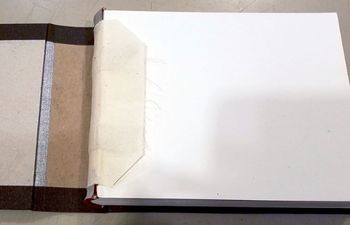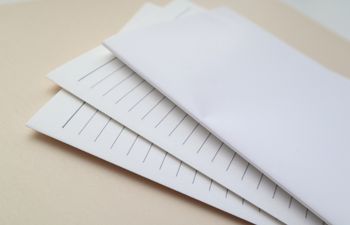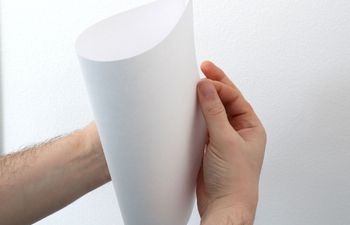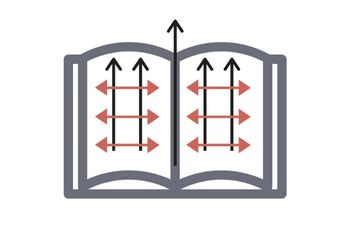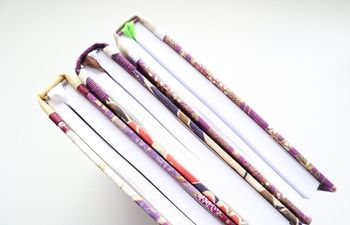When you pull a book off the shelf, you’re usually grabbing it by the spine. This is where the pages are sewn and glued together. Since the spine goes through a lot of rough handling, it’s a good idea to make sure it’s strong. In this post, I’ll show you how to reinforce the spine of your book so it will last a long time.
There are two main ways to build a strong spine: 1) by adding stuff to the spine and 2) by adding a liner to the case as it’s being made.
Additions to the Spine
You can add decades to a book’s life with just a few extra materials glued to the spine of the text block. Here’s how it’s done:
- Once the folded paper (called “signatures” or “sections”) are sewn, a layer of paste is added over top where they meet. This is the spine we all refer to. The glue fills in tiny gaps between each signature.
- Next, a strong piece of material called a “mull” (also known as a “super,” “muslin,” or “crash”) is added over the paste while it’s still a little wet. A mull is usually made of linen, but there are different kinds you can buy (don’t worry, they all do the same thing).
- Another layer of paste is added over top of the mull, and then a paper liner is put down. This liner is a final layer of protection and helps to make the spine more smooth.
Now, the book is ready to be covered.
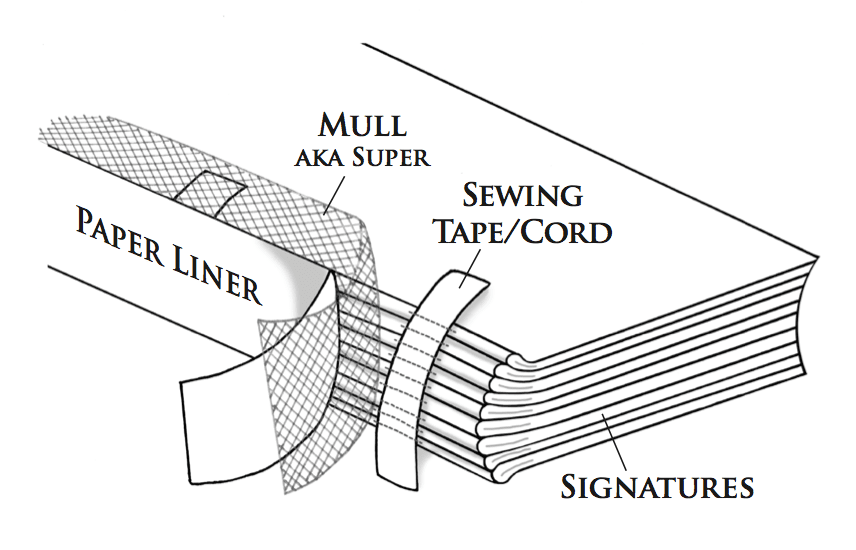
Adding a Liner to the Case
If your book has a cover, you can add a piece of heavyweight paper such as cover stock, 2-ply cardboard, index cards, watercolor paper or Bristol, to the covering. This adds a barrier between the cloth and text block and also gives the spine more structure.
The benefit to using a 2-ply cardboard or heavyweight paper is the ability to shape the liner so it fits a rounded spine. A piece of the same book board used for the covers is also an option and often used, but isn’t as flexible. This is okay, though – many love the squared look of a thick spine. It’s all up to your preference!
As you can imagine, adding both of these elements can really give your spine the strength it needs to survive heavy handling. If your book won’t be used much, then just stick with the text block reinforcement steps and you’re good to go!
What to Use & When
| Step | Material | What to Use | Where to Buy |
|---|---|---|---|
| Additions to the Spine | Paste | PVA glue (dries clear and remains flexible so the pages can open) | Any online book binding supplier or even Amazon |
| Additions to the Spine | Mull (also called Super, Muslin, Tarlatan or Crash) | Open weave starched cloth, usually cotton or linen | Talas Online or Hollanders |
| Additions to the Spine | Paper liner | Tyvek, Hollytex, Evolon or any acid-free paper made of synthetic fibers | Talas Online or Hollanders |
| Adding a Liner to the Case | Heavyweight paper, 2-ply board | 100# cover stock or higher (depending on how strong you want the liner), 2-ply board (think: cereal box cardboard), or watercolor paper | Any arts and crafts store |
Resources
- Know the Difference | Book Board – perfect if you’d like to understand 2-ply and 4-ply board and their uses better.
- New to Bookbinding?
Are you new to bookbinding? Check out my New Bookbinder Guide for helpful information.
Pop over to Instagram or Facebook if you have any questions!
ALL my best,
Misty
